When an entire landscape loses its forests, it can be so complete that most of us would have no comprehension of what had once been. The trees are cut down, or burnt, the soil washes away … and the very evidence has been obliterated. For this reason the odd ancient tree or patch of original vegetation are to be treasured.
I grew-up in a semi-arid, naturally treeless part of the world – Central Otago, New Zealand. Well, actually not quite naturally. When the first European settlers came in the 1850s, it was covered in tussock and scrub. They planted poplars and fruit trees and slowly, parts of it became a treed-landscape. But there are tantalising scraps here and there that hint that the mountains and valleys, well before those settlers, were forested. They are tiny relicts of the former vegetation, sometimes just single trees, and usually in the most fire-protected spots of the most rugged areas.
When I worked in the Gobi Altai in Mongolia (the mountains to the north of the Gobi Desert) I was immediately intrigued with the similarities to my New Zealand home. It’s the same kind of landscape, the same colours, sometimes the same sky – but on a vastly larger scale. It’s Central Otago ten or a hundred times bigger. Like Central, it’s virtually treeless. But now and again there is a little green, a patch of forest surviving in a remote gorge, or almost incredibly isolated trees in the arid lowlands. After weeks at a time of not seeing plants higher than me, trees were always worth a look and some photos. This is a brief introduction to some of what I’ve seen.
In the mountains the trees are always larch – a deciduous conifer, green only in the brief Mongolian summer.
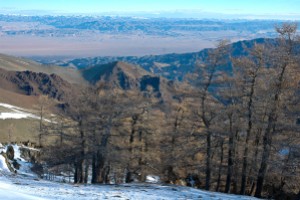
One of the small forests still remaining in the Gobi Altai. For several weeks my camp was in the distant foothills.
Not far from the track a few kilometres from one of our main camps – was this ridiculously small patch of willows. It is the only patch of trees for a huge distance around. The special place was recognised by someone, years ago, who made the effort to fence it off and protect it from the goats. Alas, the fence needs a little attention.

The highly coppiced trees inside the patch – and a fence – the remains of someone’s attempt to preserve the trees.
Some of the larger rivers have a few patches of trees along them. At the edge of the mountains these may be larch, but willow is more typical in the open country.
Now and then you come across amazingly isolated trees, in the middle of what you thought was pure desert. The Mongolians recognise these as ‘ganzmut’ (single-tree) and they are often revered as special by Buddhists. Some of these are elms.
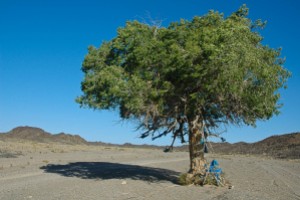
A single tree in the middle of no-where. The blue material indicates it is a special tree for Buddhists.
These remaining trees speak of what was – but importantly, what could be. The fact of their existence, however tenacious, shows that they can grow in this incredibly harsh environment. At one stage the Gobi Altai were probably covered in larch forests, and there were likely large patches of broad-leaved forest in the lowlands. All sorts of things would change with reafforestation – slow run-off would mean that rivers that now only flash-flood may flow throughout the summer, the forests themselves may have an ameliorating effect on the climate, and there could be a sustainable supply of wood for building and fuel.
It would take some special people with a bit of vision. Fortunately there are a few such people, and I’ll mention them in a later post.


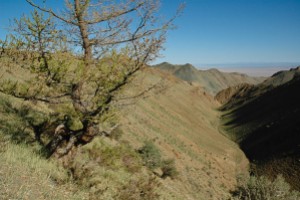
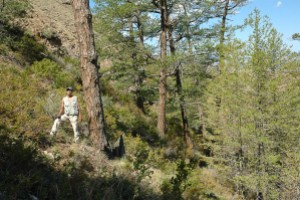
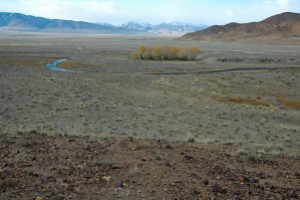
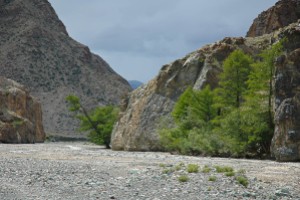


2 comments
I had the honor of knowing Gordon Robinson who was chief forester for Southern Pacific RR lands for 27 years who refused to clearcut. He had studied Silvaculture under Frederick Baker at the University of California at Berkeley . Professor Baker apparently had taken a trip to China in the 1920s to a walled city in the center of the Gobi and found some deep forest soil within the walls, while outside was the yellow silt from which the Yellow River and Yellow Sea get their color.
I do not read Chinese, but the loss of such a forest would be an institutional embarrassment of cosmic scale. Nevertheless that silt I believe is organic, as in ushering from life. Oh, is there a big story there.
Gordon Robins wrote the book: The Forest and the Trees, where he makes the case for forestry as a preservation of watershed values, even if it is seen as ‘uneconomic’ in profit maximizing logic. I wonder if the same logical flaw that is currently burning up Canadian and US forest lands was tried in ancient China.
Sorry, missed this earlier. That walled city would make a fascinating spot for future study. All sorts of interesting stuff could be gleaned from that little patch if preserved soil. And makes one wonder how many other ancient walled cities around the world might preserve tiny traces of once extensive forests?